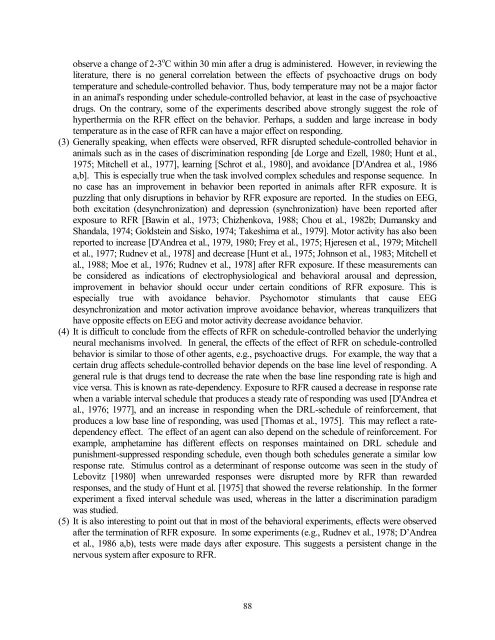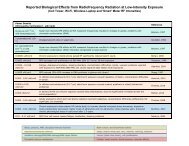Evidence for Effects on Neurology and Behavior - BioInitiative Report
Evidence for Effects on Neurology and Behavior - BioInitiative Report
Evidence for Effects on Neurology and Behavior - BioInitiative Report
Create successful ePaper yourself
Turn your PDF publications into a flip-book with our unique Google optimized e-Paper software.
observe a change of 2-3 o C within 30 min after a drug is administered. However, in reviewing the<br />
literature, there is no general correlati<strong>on</strong> between the effects of psychoactive drugs <strong>on</strong> body<br />
temperature <strong>and</strong> schedule-c<strong>on</strong>trolled behavior. Thus, body temperature may not be a major factor<br />
in an animal's resp<strong>on</strong>ding under schedule-c<strong>on</strong>trolled behavior, at least in the case of psychoactive<br />
drugs. On the c<strong>on</strong>trary, some of the experiments described above str<strong>on</strong>gly suggest the role of<br />
hyperthermia <strong>on</strong> the RFR effect <strong>on</strong> the behavior. Perhaps, a sudden <strong>and</strong> large increase in body<br />
temperature as in the case of RFR can have a major effect <strong>on</strong> resp<strong>on</strong>ding.<br />
(3) Generally speaking, when effects were observed, RFR disrupted schedule-c<strong>on</strong>trolled behavior in<br />
animals such as in the cases of discriminati<strong>on</strong> resp<strong>on</strong>ding [de Lorge <strong>and</strong> Ezell, 1980; Hunt et al.,<br />
1975; Mitchell et al., 1977], learning [Schrot et al., 1980], <strong>and</strong> avoidance [D'Andrea et al., 1986<br />
a,b]. This is especially true when the task involved complex schedules <strong>and</strong> resp<strong>on</strong>se sequence. In<br />
no case has an improvement in behavior been reported in animals after RFR exposure. It is<br />
puzzling that <strong>on</strong>ly disrupti<strong>on</strong>s in behavior by RFR exposure are reported. In the studies <strong>on</strong> EEG,<br />
both excitati<strong>on</strong> (desynchr<strong>on</strong>izati<strong>on</strong>) <strong>and</strong> depressi<strong>on</strong> (synchr<strong>on</strong>izati<strong>on</strong>) have been reported after<br />
exposure to RFR [Bawin et al., 1973; Chizhenkova, 1988; Chou et al., 1982b; Dumansky <strong>and</strong><br />
Sh<strong>and</strong>ala, 1974; Goldstein <strong>and</strong> Sisko, 1974; Takeshima et al., 1979]. Motor activity has also been<br />
reported to increase [D'Andrea et al., 1979, 1980; Frey et al., 1975; Hjeresen et al., 1979; Mitchell<br />
et al., 1977; Rudnev et al., 1978] <strong>and</strong> decrease [Hunt et al., 1975; Johns<strong>on</strong> et al., 1983; Mitchell et<br />
al., 1988; Moe et al., 1976; Rudnev et al., 1978] after RFR exposure. If these measurements can<br />
be c<strong>on</strong>sidered as indicati<strong>on</strong>s of electrophysiological <strong>and</strong> behavioral arousal <strong>and</strong> depressi<strong>on</strong>,<br />
improvement in behavior should occur under certain c<strong>on</strong>diti<strong>on</strong>s of RFR exposure. This is<br />
especially true with avoidance behavior. Psychomotor stimulants that cause EEG<br />
desynchr<strong>on</strong>izati<strong>on</strong> <strong>and</strong> motor activati<strong>on</strong> improve avoidance behavior, whereas tranquilizers that<br />
have opposite effects <strong>on</strong> EEG <strong>and</strong> motor activity decrease avoidance behavior.<br />
(4) It is difficult to c<strong>on</strong>clude from the effects of RFR <strong>on</strong> schedule-c<strong>on</strong>trolled behavior the underlying<br />
neural mechanisms involved. In general, the effects of the effect of RFR <strong>on</strong> schedule-c<strong>on</strong>trolled<br />
behavior is similar to those of other agents, e.g., psychoactive drugs. For example, the way that a<br />
certain drug affects schedule-c<strong>on</strong>trolled behavior depends <strong>on</strong> the base line level of resp<strong>on</strong>ding. A<br />
general rule is that drugs tend to decrease the rate when the base line resp<strong>on</strong>ding rate is high <strong>and</strong><br />
vice versa. This is known as rate-dependency. Exposure to RFR caused a decrease in resp<strong>on</strong>se rate<br />
when a variable interval schedule that produces a steady rate of resp<strong>on</strong>ding was used [D'Andrea et<br />
al., 1976; 1977], <strong>and</strong> an increase in resp<strong>on</strong>ding when the DRL-schedule of rein<str<strong>on</strong>g>for</str<strong>on</strong>g>cement, that<br />
produces a low base line of resp<strong>on</strong>ding, was used [Thomas et al., 1975]. This may reflect a ratedependency<br />
effect. The effect of an agent can also depend <strong>on</strong> the schedule of rein<str<strong>on</strong>g>for</str<strong>on</strong>g>cement. For<br />
example, amphetamine has different effects <strong>on</strong> resp<strong>on</strong>ses maintained <strong>on</strong> DRL schedule <strong>and</strong><br />
punishment-suppressed resp<strong>on</strong>ding schedule, even though both schedules generate a similar low<br />
resp<strong>on</strong>se rate. Stimulus c<strong>on</strong>trol as a determinant of resp<strong>on</strong>se outcome was seen in the study of<br />
Lebovitz [1980] when unrewarded resp<strong>on</strong>ses were disrupted more by RFR than rewarded<br />
resp<strong>on</strong>ses, <strong>and</strong> the study of Hunt et al. [1975] that showed the reverse relati<strong>on</strong>ship. In the <str<strong>on</strong>g>for</str<strong>on</strong>g>mer<br />
experiment a fixed interval schedule was used, whereas in the latter a discriminati<strong>on</strong> paradigm<br />
was studied.<br />
(5) It is also interesting to point out that in most of the behavioral experiments, effects were observed<br />
after the terminati<strong>on</strong> of RFR exposure. In some experiments (e.g., Rudnev et al., 1978; D’Andrea<br />
et al., 1986 a,b), tests were made days after exposure. This suggests a persistent change in the<br />
nervous system after exposure to RFR.<br />
88



